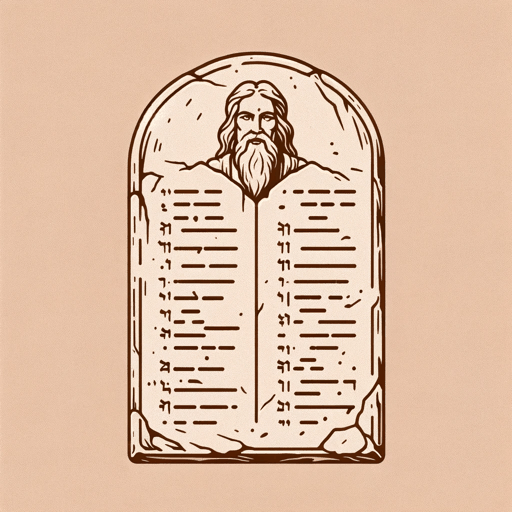74 pages • 2 hours read
AnonymousBible: Old Testament: English Standard Version
Nonfiction | Scripture | Adult | Published in 1611A modern alternative to SparkNotes and CliffsNotes, SuperSummary offers high-quality Study Guides with detailed chapter summaries and analysis of major themes, characters, and more.
Summary
Background
Pentateuch (Genesis-Deuteronomy)
Historical Books Part 1 (Joshua-Ruth)
Historical Books Part 2 (1 Samuel-2 Chronicles)
Historical Books Part 3 (Ezra-Esther)
Wisdom Literature (Job-Song of Solomon)
Major Prophets (Isaiah-Daniel)
Minor Prophets Part 1 (Hosea-Micah)
Minor Prophets Part 2 (Nahum-Malachi)
Key Figures
Themes
Index of Terms
Important Quotes
Essay Topics
Further Reading & Resources
Summary and Study Guide
Overview
The Old Testament is one of two major sections of the Christian Bible, comprising a collection of 39 books which come from the ancient Israelite context of the second and first millennia BCE, written almost entirely in Hebrew. A similar collection of books also comprises the standard canon of Jewish scriptures, referred to in that context as the Hebrew Bible (or Tanakh). Within the Christian tradition, the Old Testament is paired with the shorter New Testament, a collection of 27 books attributed to the first century CE, and together these 66 books comprise the standard canon of Christian scripture. Standing as canonical scripture in both Jewish and Christian circles, the texts of the Old Testament occupy a central place in the history of world religions and in the philosophical roots of several major world civilizations.
The Old Testament books have been passed down through centuries of scribal copies, and the earliest and most complete manuscripts from these text-traditions form the basis of modern translations. This study guide uses the English Standard Version (ESV) of 2016 from the publisher Crossway. Readers of this study guide can use any English translation according to their own preference, as all citations are given with the standard biblical reference system (designating book, chapter, and verse), a reference apparatus that is uniform across all English versions.
This study guide follows the Old Testament pattern and traditional Christian usage by using male pronouns for God, but it is important to note that the Christian tradition regards God as spirit (and so ungendered). As such, the pronouns for God in this guide ought not to be read as expressions of human gender but rather as indicating the relational analogies through which the biblical books portray God’s interactions with humanity.
Scripture quotations are from the ESV® Bible (The Holy Bible, English Standard Version®), copyright © 2001 by Crossway, a publishing ministry of Good News Publishers. ESV Text Edition: 2016. Used by permission. All rights reserved. The ESV text may not be quoted in any publication made available to the public by a Creative Commons license. The ESV may not be translated into any other language.
Summary
The Old Testament represents a broad variety of literary genres and styles, including history, legal codes, poetry, philosophical wisdom, songs, laments, romances, and prophecies. Many of the Old Testament books employ more than one literary style, but they can often be categorized broadly with reference to a single genre. The traditional Christian arrangement of Old Testament books thus follows a literary arrangement, with occasional adjustments made for chronology. The first five books (Genesis-Deuteronomy) stand as their own unique grouping, comprising the history and legal codes of the patriarchal and exodus periods, called the Pentateuch in Christian tradition. The next section is composed of historical books (Joshua-Esther), followed by a group of poetical and philosophical books called wisdom literature (Job-Song of Solomon). Finally, there are the books of the prophets, which are usually separated into major prophets (Isaiah-Daniel) and minor prophets (Hosea-Malachi).
The Old Testament traces the story of God’s relationship with humanity (and, in particular, with the people of Israel) from the creation of the world through the rise of the Persian Empire in the mid-first millennium BCE. While there are a broad range of opinions regarding the chronology of the opening chapters of the Old Testament, the vast majority of Old Testament texts (from Genesis 12 onward) offer a portrayal of about a millennium and a half of history, from the beginning of the second millennium BCE to the mid-first millennium. The earlier chapters of Genesis relate the primeval history of earth: its creation by God, his relationship with the first humans, and the subsequent fall of humanity into sin, which leads to major acts of divine judgment. The history covered by the Old Testament thereafter can be understood in four major periods (designated by approximate date ranges based on the Old Testament’s internal chronology): first, the patriarchs and the sojourn in Egypt (2000-1450 BCE); second, the exodus and the early settlement of Canaan (1450-1050 BCE); third, the monarchy in Israel/Judah (1050-600 BCE); and fourth, the period under Babylonian and Persian rule (600-400 BCE).
The first major period after the primeval history narrated in Genesis is that of the patriarchs and the sojourn in Egypt. God establishes a personal covenant with the Hebrew patriarch Abraham in which Abraham’s faith is rewarded with promises of descendants and a future inheritance of the land of Canaan (modern Israel/Palestine). Abraham travels to Canaan, where his family members live as nomadic pastoralists until a famine necessitates their emigration to Egypt. While there, their population grows so rapidly that the Egyptian government feels threatened and responds by enslaving the Israelites.
The second major period (narrated in the books from Exodus to Ruth) begins when God calls Moses to lead the Israelites out of enslavement. God dispenses a series of plagues against Egypt when the Pharaoh refuses to release the Israelites from bondage, eventually leading to the Israelites’ dramatic deliverance to safety through the Red Sea. The Israelites travel to Mount Sinai, and there God delivers to Moses his covenant of law, including the Ten Commandments. After receiving the law of God, the Israelites are meant to enter Canaan and take possession of their “Promised Land,” but they disobey God’s command and must wander a further 40 years in the desert. After the 40 years are done, Moses dies and the Israelites enter Canaan under the leadership of Joshua, who leads a series of successful campaigns against the Canaanite city-states. The Israelites begin to settle the land, but their conquest is incomplete, leading to a turbulent period in which God must raise up successive leaders, called judges, to represent Israelite interests against various challenges.
The third major period, the Israelite monarchy, is narrated in the books from 1 Samuel to 2 Chronicles, and many of the books of wisdom and prophecy are situated within its historical context. Samuel, the last of the judges, consents to the establishment of a monarchy and anoints Israel’s first king, Saul. Saul proves to be a poor king, so Samuel is led by God to anoint the next king, a boy named David. David distinguishes himself with impressive military feats, like overcoming the gigantic Philistine soldier Goliath, and ascends the throne after Saul’s death. David, held up as the great standard of Israelite kingship, faces a tumultuous reign made difficult by multiple challenges, including his own moral failures, but his defining virtue is his steadfast faith in God. David’s son Solomon reigns after him, building a temple for God in the capital of Jerusalem and establishing a period of stability. After the first three kings, Israelite society splits into two rival monarchies, the nation of Israel in the north and the nation of Judah in the south. The northern kings are disinclined to follow God’s ways and fall relatively quickly; Israel is subsumed into the Assyrian Empire in 722 BCE. The southern kings fare somewhat better but are also marked by widespread disregard of God’s directions, leading to their eventual conquest by the Babylonian Empire in 605 BCE and the complete destruction of Jerusalem some 20 years later.
The fourth major period, under the Babylonian and Persian empires, is narrated in the historical books of Ezra, Nehemiah, and Esther, as well as in prophetic books like Ezekiel and Daniel. The Babylonian period is referred to as “the exile,” because many Jews (the citizens of Judah) were forced to immigrate to Babylon, and were not permitted to return until the Babylonian Empire fell to the Persians. The return from exile under leaders like Ezra and Nehemiah begins a period of Jewish history referred to as “post-exilic,” in which Jews are once again able to live in their land and practice their faith, but without political autonomy. The biblical literature from this period celebrates the Jews’ return to their own land, but also looks forward to a fuller restoration of covenant-promises to come, an expectation that consolidates around the hope of a future messianic leader.
The historical narrative presented by the Old Testament is bound together by the narrative arc of God’s relationship with the people of Israel. It is not so much a national history as a theological history, defined more by God’s actions than by a simple sequence of events. God is presented as the initiator and the active agent at every stage of Israel’s history, from his call to Abraham to his provision of a restoration from exile. The leaders of Israelite history are not judged by the success of their policies or military actions, but by their faith in God and their adherence to his laws. In the Old Testament, religion and political history are not two separate realms of social existence, but are inextricable.
Related Titles
By Anonymous

Arabian Nights
Anonymous

Arden of Faversham
Anonymous

A Woman in Berlin
Anonymous

Bible: New Testament: English Standard Version
Anonymous

Deuteronomy
Anonymous

Diary of an Oxygen Thief
Anonymous

Do Not Stand at My Grave and Weep
Anonymous

Everyman
Anonymous

Hebrew Bible
Anonymous

Holy Bible
Anonymous

Homeric Hymns
Anonymous

Judith
Anonymous

Laxdaela Saga
Anonymous

Lazarillo De Tormes
Anonymous

Mahabharata
Anonymous

Nibelungenlied
Anonymous

Njals Saga
Anonymous

One Thousand and One Nights
Anonymous

Popol Vuh
Anonymous

Sir Gawain and the Green Knight
Anonymous

